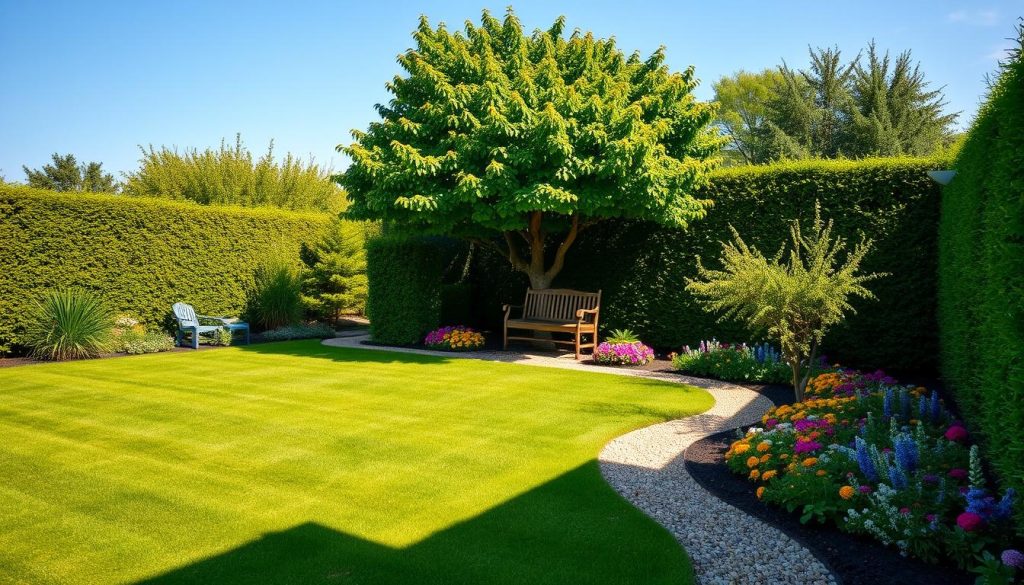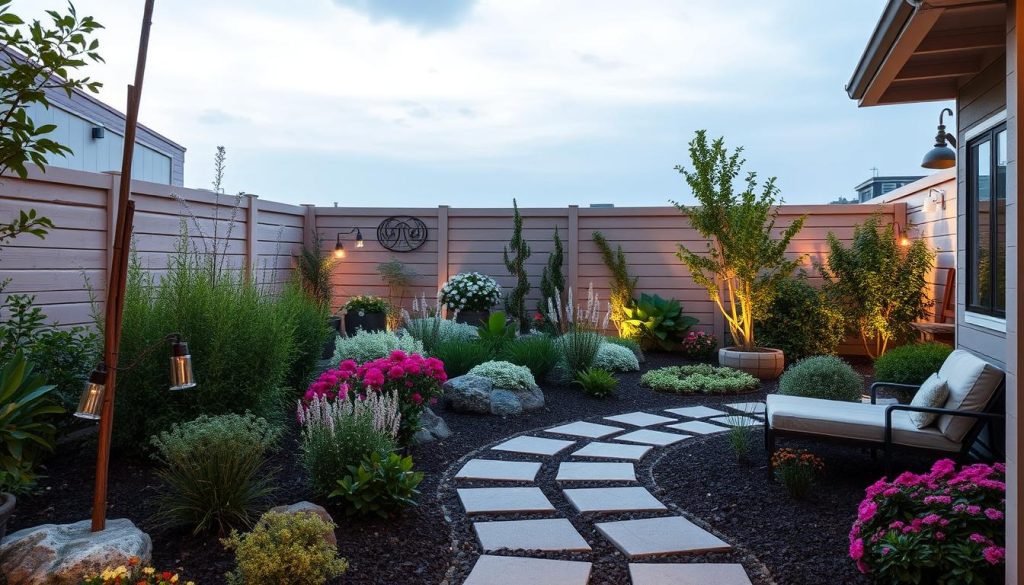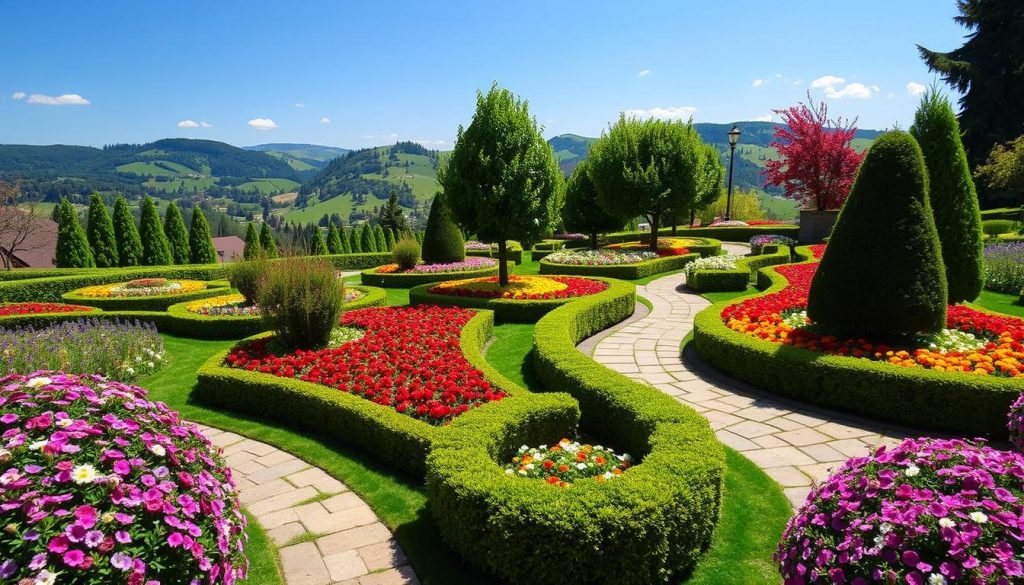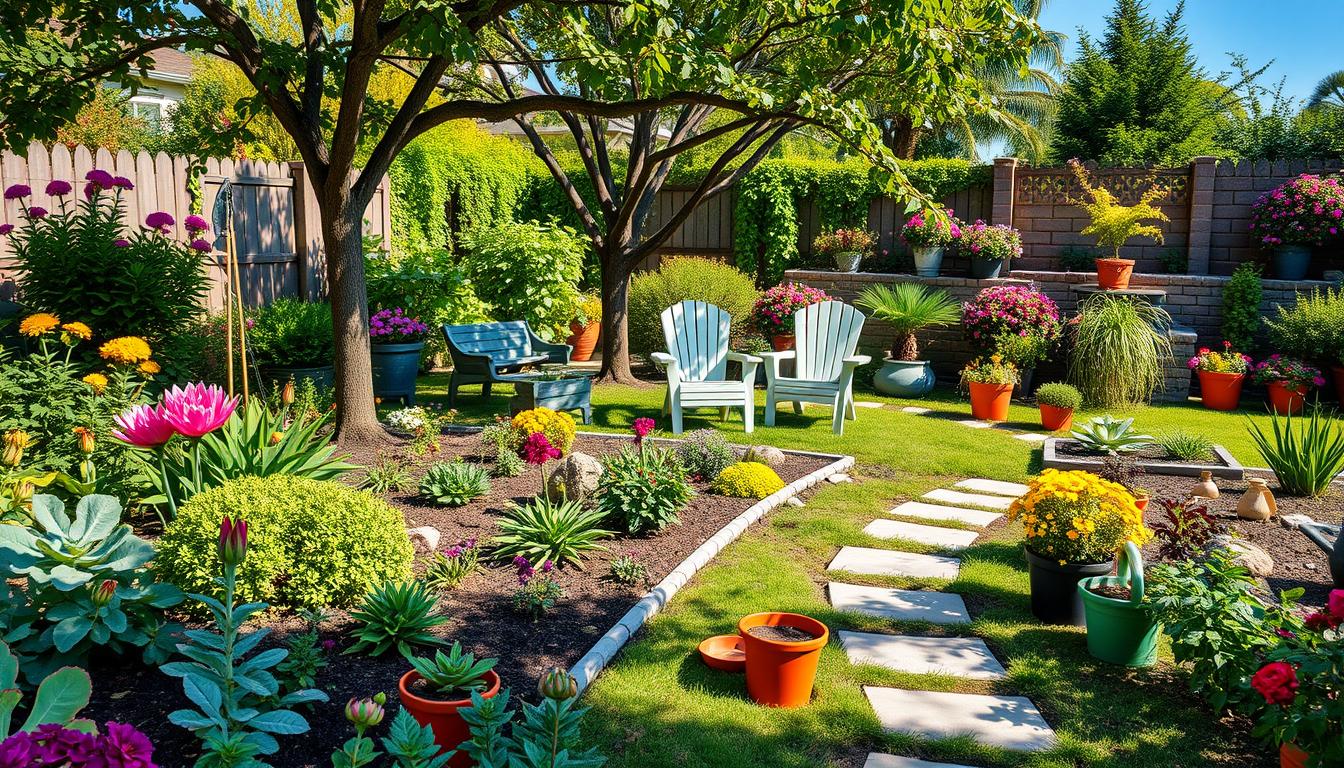Starting with landscaping can feel overwhelming. That’s why I’m here to share my top tips for beginners. These tips will help you create a beautiful outdoor space that shows off your style.
If you’re new to landscaping, this guide is for you. It covers the basics, like understanding different styles and what elements to focus on. This will help you make your yard look amazing.
My tips will teach you how to evaluate your outdoor area and pick the right plants and materials. I’ll also share my favorite advice for beginners. These easy tips will kickstart your landscaping journey.
Understanding the Basics of Landscaping
Starting my landscaping journey, I see how important the basics are. Simple landscaping ideas and beginner gardening tips help me. They ensure my outdoor space is both beautiful and functional.
Landscaping changes and improves my yard’s natural features. It makes my outdoor area look good and work well. I can pick from many styles, like modern, traditional, or rustic, to match my taste.
What is Landscaping?
Landscaping is a mix of art and science. It needs knowledge of plants, design, and the environment. This way, I can make a space that shows who I am and looks great.
Different Landscaping Styles
There are many landscaping styles:
- Modern: clean lines, simple, and functional
- Traditional: classic, symmetrical, and detailed
- Rustic: natural materials, cozy, and welcoming

Key Elements to Consider
When designing, I think about plants, hardscapes, and water features. These elements make my design come alive. They help make my outdoor space beautiful, valuable, and peaceful.
Assessing Your Outdoor Space
Assessing your outdoor space is key for beginners in landscape design. You need to know your yard’s size, where the sun and shade are, and the soil types. This info helps pick the right plants, hardscapes, and water features for your design.
Start by walking around your yard. Look at how much sunlight each spot gets and the soil type. This helps choose plants that will do well there. You can also use online tools or get advice from a pro to figure out your yard’s size and layout.

Here are some important things to think about when checking out your outdoor space:
- Yard size: Measure the length and width to find out the total area.
- Sun and shade areas: Find out which spots get full sun, partial shade, and full shade.
- Soil types: Check the soil type in each area, like clay, sand, or loam.
By thinking about these points and using simple landscape techniques, you can make a beautiful and lively outdoor space. It will meet your needs and look great with your home, perfect for beginners in gardening and landscape design.
Planning Your Landscape Design
Starting your landscaping journey is exciting and creative. You can make a beautiful outdoor space that shows your style and meets your needs. Begin by checking out your outdoor area, thinking about what you want, and looking for inspiration.
One idea is to make a vision board. Collect images that excite you and arrange them to see your dream space. Use magazines, books, or the internet for ideas. You can also use design software to see your design come to life. These programs let you play with layouts and make changes before you start.
Creating a Vision Board
- Gather images and ideas that inspire you
- Arrange them in a way that helps you visualize your ideal outdoor space
- Use magazines, books, or online resources to find ideas and inspiration
Using Design Software or Tools
Design software or tools can make your landscape design real. There are many options like landscape design software, online tools, and apps. They help you create designs, try out layouts, and tweak them before starting. These tips can help you make a space that’s both beautiful and useful.

Sketching Your Layout
Sketching your layout is a simple way to plan. First, measure your space and make a rough sketch. Then, draw out your ideas with a pencil and paper. Think about sunlight, drainage, and how easy it is to get around. These tips can help you create a space you’ll love for a long time.
| Design Element | Description |
|---|---|
| Vision Board | A visual representation of your ideal outdoor space |
| Design Software | A tool used to create a 2D or 3D design of your landscape |
| Sketching | A simple and effective way to plan your landscape design |
Choosing the Right Plants
Starting your gardening journey can feel daunting. With so many plants to choose from, it’s key to think about your climate, soil, and how much care they need. Native plants are a great choice because they fit well with your local weather and need less upkeep.
When designing your landscape, think about the look you want. Consider the colors, textures, and sizes of your plants. For example, seasonal flowers can brighten up your yard. Shrubs and trees add structure and depth. Mixing different plants and knowing their care needs can make your landscape both beautiful and easy to maintain.

- Climate and hardiness zone
- Soil type and drainage
- Maintenance requirements, such as watering and pruning
- Space and growth habits
By considering these factors and using simple landscape techniques, you can create a stunning outdoor space. It will meet your needs and enhance your yard.
Hardscaping Essentials
Starting with landscaping? Hardscaping is key to a beautiful outdoor area. It uses materials like stone, brick, and concrete for walkways, driveways, and patios. Easy tips and simple ideas can help you create a space that looks good and works well.
What is Hardscaping?
Hardscaping makes your outdoor area look better. With beginner-friendly tips, you can make a stunning hardscape. It will match your plants and flowers perfectly.
Common Hardscape Materials
Pavers, retaining walls, and patios are common hardscape materials. They can add outdoor kitchens and fire pits, making your space more valuable and useful. Simple ideas and easy tips can help you stay within your budget while creating something beautiful.
Integrating Hardscape with Softscape
It’s important to mix hardscape with softscape for a balanced look. The right materials and plants can make your outdoor space stunning. With beginner-friendly tips and simple ideas, you’ll have a space you’ll love for years.
Water Features in Landscaping
Adding water features to your landscaping can make your space more interesting and calming. You can find beginner advice to help you pick the perfect water feature. Start with something simple like a small fountain or pond, then move on to bigger projects like waterfalls or streams.
Water features can really enhance your yard’s look by adding depth and texture. Here are some popular types:
- Ponds: create a peaceful and serene atmosphere
- Fountains: add elegance and sophistication
- Waterfalls: make a dramatic and eye-catching feature
Adding water features can make your outdoor space unique and beautiful. With the right advice, you can create a stunning water feature that fits your style and home. For more ideas, talk to a landscaper or do some online research.
Here is a table summarizing some popular water features and their maintenance requirements:
| Water Feature | Maintenance Requirements |
|---|---|
| Pond | Regular cleaning, water testing, and algae control |
| Fountain | Regular cleaning, pump maintenance, and water testing |
| Waterfall | Regular cleaning, pump maintenance, and water testing, as well as occasional rock and plant maintenance |
Enhancing Curb Appeal
As a beginner in landscaping, I’ve learned that enhancing curb appeal is key. Curb appeal is the first impression your home and yard give to visitors. To boost your home’s curb appeal, try adding colorful flowers or trimming shrubs.
Understanding color theory in landscaping is crucial for beginners. The right colors for plants, flowers, and hardscaping can make your outdoor space beautiful. Beginner gardening tips can also help you use your space well, whether it’s small or large.
Simple Changes for Immediate Impact
- Add colorful flowers or plants to your front yard
- Trim shrubs and trees to maintain a neat appearance
- Paint your front door a bold, welcoming color
Color Theory in Landscaping
Color theory in landscaping is vital for a beautiful outdoor space. Choosing colors that match your home and style creates harmony. Use beginner gardening tips, like native plants or seasonal flowers, to add color and interest.
Garden Maintenance Tips
Starting with landscaping can be exciting. It’s key to know how to keep your garden looking great. Simple tips like watering and fertilizing can make a big difference.
Using easy landscaping tips helps a lot. For example, pruning and weeding keep your plants in check. Here are some tips to help you:
- Water your plants deeply but infrequently to encourage deep root growth
- Fertilize your plants regularly to promote healthy growth
- Prune your plants to maintain shape and promote new growth
Regular Watering and Fertilizing
Watering and fertilizing are vital for your plants. A simple schedule can keep them healthy and growing well.
Pruning and Weeding Practices
Pruning and weeding are crucial for your garden’s look. They help keep your plants in shape and prevent them from getting too big. Adding these to your routine will make your garden look its best.
Seasonal Preparation Strategies
Getting ready for each season is important. Cleaning up and using mulch can help. These steps ensure your garden stays beautiful all year.
Landscaping Tools Every Beginner Needs
Starting in landscaping means you need the right tools. These tools help you follow beginner gardening tips and landscaping tips. You’ll need the right equipment to do basic landscape techniques. Let me show you the essential tools for beginners.
Essential Hand Tools
Beginners should have basic hand tools. These include gloves, pruning shears, and a trowel. They help with tasks like planting, pruning, and weeding. Here are some tools you should consider:
- Gloves: to protect your hands from thorns and dirt
- Pruning shears: to trim and prune plants
- Trowel: to dig and plant
Power Tools for Landscaping
Power tools make landscaping easier and faster. Beginners should have lawn mowers, trimmers, and edgers. These tools help with tasks like mowing, trimming, and edging your lawn.
Safety Equipment and Gear
Safety is key when working in the yard. You’ll need safety glasses, ear protection, and a first aid kit. With the right tools and safety gear, you can create a beautiful outdoor space.
| Tool | Description |
|---|---|
| Gloves | Protect hands from thorns and dirt |
| Pruning Shears | Trim and prune plants |
| Trowel | Dig and plant |
Understanding Local Plant Hardiness Zones
As a beginner in landscaping, knowing your local plant hardiness zones is key. It helps create a beautiful outdoor space. By following beginner landscaping tips, your plants will grow well in your area.
Choosing the right plants is crucial. The hardiness zone of your area matters a lot. It shows where a plant can grow and thrive based on temperature. Knowing your zone helps pick plants that fit your climate, making your yard look great.
What is a Hardiness Zone?
A hardiness zone is a geographical area based on its average annual extreme minimum temperature. This info is vital for picking plants that will do well in your area.
Finding Your Zone
To find your hardiness zone, use online tools or talk to a local nursery or gardening expert. This helps you choose the right plants for your landscape.
Adapting Landscaping to Your Zone
Knowing your hardiness zone lets you tailor your landscaping. Consider soil type, sunlight, and moisture levels. These are important for beginners. By doing this, you can create a beautiful and functional outdoor space that suits your needs and home’s look.
Understanding and adapting to your local plant hardiness zone is the first step to a beautiful outdoor space. With beginner landscaping advice and easy tips, you’ll enjoy your outdoor area for years.
Resources for Continued Learning
Starting your landscaping journey is just the beginning. The world of gardening and outdoor design is always changing. There’s always more to learn. So, it’s key to explore the many resources available for beginner gardeners.
Books and Online Courses
Find guides and tutorials that cover all aspects of landscaping. From basic techniques to advanced design, there’s a lot to learn. Classic books and online courses are full of information to help you grow your skills.
Local Gardening Clubs and Workshops
Joining local gardening clubs and workshops can be a big help. They offer hands-on learning and a chance to meet others who love gardening. You’ll get new tips and insights from experts at these events.
Websites and Online Communities
The internet is full of great resources for gardeners. Look for websites and forums focused on beginner gardening tips and techniques. These places are filled with advice and inspiration from experts and fellow gardeners.
Using these resources will help you become a landscaping expert. You’ll create an outdoor space that makes your home look great and brings you joy. Happy gardening!

